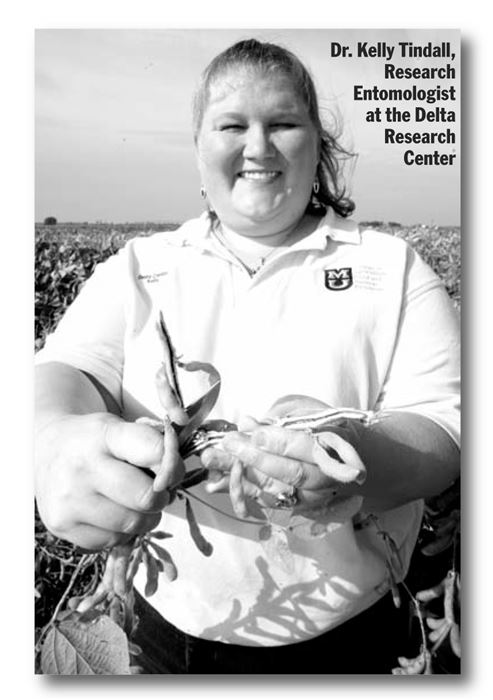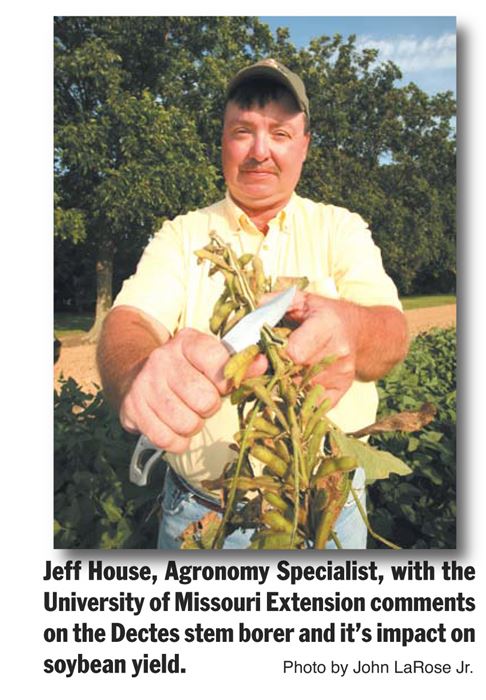Soybean Stem Borer
Tests In Five States Seek To Understand Dectes Stem Bore r In Soybeans
PORTAGEVILLE, MO.
Researchers in five states of Tennessee, Kentucky, Arkansas, Missouri and Kansas have been conducting research on the Dectes soybean stem borer. Data show that the stem borer is widespread and infests about 40 percent to 50 percent of soybean fields at rates from 0 percent to 100 percent in Missouri, Arkansas and Tennessee.
Dr. Kelly Tindall, research entomologist at the Delta Research Center, discussed the work underway in the Bootheel.

“Dectes stem borer is a grey beetle with long striped antenna,” she explained. “What happens is the females lay eggs in the petiole, larvae will hatch and feed in the petiole leaf. Then they’ll move through the petiole to the main stem and bore into the main stem and eat the pith and the vascular tissue of the soybean plant.” Researchers in the five states where studies are underway are seeing evidence of the pests, in some cases the fields are nearly 100 percent infected.
“What that means is that at the end of the year when we split stems of 50 plants, 50 plants have been tunnelled,” Tindall said. “So it’s a really high infestation in many places. It appears that they are attracted to the wheat beans compared to beans planted in April or May. There’s a lot of questions that we’re trying to answer about the biology so we can figure out exactly which group of beans are more susceptible. If there’s a planting date, a maturity date, all those type of questions need to be addressed.” Some things have been learned from the study. One is there are at least two parasites of Dectes in soybeans; however the rate of infestation is low. The parasites are able to find larvae though.
In the study, only 30 percent of the tunneled stems had Dectes larvae present. Whether the Dectes larvae were in the top of the plant when the beans were harvested, whether a parasite consumed the Dectes, whether the Dectes died of other causes and dessicated to the point of non-recognition, or if there was a partial second generation or some other cause is not known. However, Missouri data show that there is a high survival among the larvae recovered, which means they are likely to be problematic this year.
Early literature stated that “moisture” may reduce Dectes’ survival. However when fields in the Mississippi River bottom in Missouri were sampled after flooding, live larvae were found. Further studies have shown that larvae are still alive after being under water for four to six weeks. In other words, larvae that appeared dead may have been alive.
Also, whole beans left in the ground as CSP land do not necessarily provide more protection from the environment than stubble beans. In one field, researchers had 85 percent infested stems in beans not harvested, versus 85 percent in stubble two to four inches tall.
“Another thing that we’ve done in the Bootheel is look at overwintering and peak emergence,” Tindall said. “We’re studying the emergence because once the egg is laid insecticides are not a viable option. You can only target the adults.”
There is a systemic insecticide called Regents that is very active on Dectes, but the EPA is not interested in pursuing that as an option at this time. Another issue considered at this time is yield losses attributed to it.
“In some cases we do have yield losses, in some cases we don’t, and in others we may see slight increases in yield. We don’t really know what is going on,” she added. “We’re trying to tease out those differences, maybe it is a varietal difference and maybe it’s a maturity group difference. Basically, there’s just a lot of questions we don’t have answers to at this point. But trying to find the peak emergence is going to be key if we have to go after it with shots of pyrethroid and/or other insecticides.”
She said the Dectes start emerging in May and they’re found in the field as adults all the way until October, so there’s almost a six month window where they’re present. There will have to be multiple applications going out to cover that long a period of time. Another thing that isn’t known is the period when soybeans are most vulnerable to Dectes infestation. So knowing when the beetles are out and when the plant is vulnerable will help determine when insecticides will be most useful.
Tindall said Dectes was a problem back in the late 1960s, early 1970s. It was when it was discovered to be a pest in soybeans for the first time near Wardell, Mo.
“So it has some local history. After the mid 1970s, and then it just went away except for isolated cases, and nobody knows why,” Tindall said. “Now we’re just trying to pick up the wheel again because agriculture has changed so much from the 1960s and 1970s until today. Dectes has a lot of alternate hosts, like ragweed and sunflower and there are a lot of ragweed problems right now.”
When Dectes was first discovered, cocklebur was as prevalent as ragweed is now. Some people are thinking that the high number of ragweed present today may be contributing to the big problem.
“Some research we’ve done this past winter showed that soybean is a good enough host, and even if the ragweed goes away, the Dectes are likely to be around,” Tindall said. “There are a lot of unanswered questions, but we have a lot of different research going on trying to address some of the questions.”
Jeff House, agronomy specialist, also commented on the studies underway.

“We have some research plots out and we’re looking at some experimental treatments,” he said. “We’re also looking at some other things like date of planting, population dynamics to see how this is going to affect the kind of damage we get from the Dectes stem borer.”
House said the main thing that needs to be looked at is yield impact.
“In some areas it was devastating in 2007,” he said. “On irrigated beans, we normally don’t see as much damage because they’re able to overcome a lot of the damage. Dryland, we had some fields that Dectes took out and people said ‘well it’s because it was droughty soil.’ No, it wasn’t because it wasn’t a droughty soil. Usually a droughty soil will not put a lot of height on a plant. These plants were two, three foot tall and they looked like they died in two or three days.”
The Dectes took out whole fields. Between Gideon and the Portageville area there were large spots of dead plants right next to fairly live healthy looking plants, which also showed it was not droughty soil.
“When you split every dead plant, it had a Dectes stem borer in it,” he added. “You split every live plant and it didn’t have one in it, so maybe they didn’t impact that area as hard as they did some other areas.”
While many areas got plenty rain last year, the Bootheel area had only a tenth of an inch of rain in June.
“We probably got less than two inches in July, and we didn’t catch much in August,” he continued. “The thing I think is helped us the most last year is we had two weeks in 2007 of temperatures over 100 degrees for two weeks. We didn’t have that last year. You can’t throw heat stress, moisture stress and insect damage stress on the plant at one time. I’ve always said I think we can fight off two of them but I don’t think we can fight off all three of them. I think 2007 and last year proves the point.”
House stressed that researchers are working on the problem it is hoped there will be answers soon, however funding for the work is short.
“Research is a lot like drag racing, how fast do you want to go?,” he said. “We’ve got people that have stepped forward and are helping with some of this but the bottom line is funding is short and we’ve got to go where we can get the most bang for our buck. We had some really good trials out last year, we’re proud of them but until the combine hits the field we don’t know what the actual outcome is going to be.” Δ
Dr. Kelly Tindall, Research Entomologist at the Delta Research Center
Jeff House, Agronomy Specialist, with the University ofMissouri Extension comments on the Dectes stemborer and it’s impact on soybean yield.
Photo by John LaRose Jr.